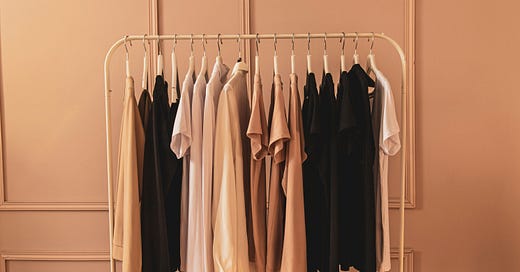Hello friend,
Can I talk to you about TikTok fashion for a second? (I promise, I’m going somewhere with this).
Photo by piotr szulawski on Unsplash
On everyone’s favourite clock app, new aesthetics seem to rise and fall seemingly overnight. One day everyone’s all about the “clean girl” look, the next, we’re doing “mob wife.” (One delightful satire predicts “bewildered mailman,” “normcore Pagliacci,” and “sneaky little court jester” as the top fashion trends of 2024).
But I’ve recently discovered another side of TikTok, where slow fashion creators promote not buying into the trends. And maybe not buying anything at all—at least not for a while.
Take Mandy Lee, fashion analyst and creator of the 75 Hard Style challenge. Not to be confused with the (quite frankly exhausting sounding) fitness challenge of the same name, it’s a pledge to spend 75 days getting dressed, documenting your outfits, and crucially, not buying anything new. Through repeating pieces and outfits—wearing your clothes and building relationships with them—you create a sense of style that’s uniquely yours.
She has a point: While constantly revamping your wardrobe might make you feel like you’re becoming more fashionable, it can pose a barrier to developing personal style. It’s hard to build anything lasting on constantly shifting sands.
I think the same is true of “style” more broadly, whether that’s your writing voice, design aesthetic, or musical taste. It’s only through repetition that you get anywhere interesting. I love this anecdote from Oliver Burke’s fantastic book, Four Thousand Weeks (it’s a little lengthy but well worth the read, I promise):
“More often than no, orginality lies on the far side of unorginality. The Finnish American photographer Arno Minkkinene dramatizes this deep truth about the power of patience with a parable about Helsinki’s main bus station. There are two dozen platforms there, he explains, with several different bus lines departing from each one—and for the first part of its journey, each bus leaving from any given platform takes the same route through the city as all the others, making identical stops. Think of each one representing one year of your career, Minkkinen advises photography students. You pick an artistic direction—perhaps you start working on platinum studies of nudes—and you begin to accumulate a portfolio of work. Three years (or bus stops later), you proudly present it to the owner of a gallery. But you’re dismayed to be told that your pictures aren’t as original as you thought, because they look like knockoffs of the work of the photographer Irving Penn; Penn’s bus, it turns out, has been on the same route as yours. Annoyed at yourself for having wasted three years following someone else’s path, you jump off that bus, hail a taxi, and return to where you started at the bus station. This time you board a different bus, choosing a different genre of photography in which to specialize. But a few stops later, the same thing happens: you’re informed your new body of work seems derivative, too. Back you go to the bus station. But the pattern keeps on repeating: nothing you produce ever gets recognized as being truly your own.
What’s the solution? ‘It’s simple,’ Minkkinen says. ‘Stay on the bus. Stay on the fucking bus.’ A little farther out on their journeys through the city, Helsinki’s bus routes diverge, plunging off to unique destinations as they head through the suburbs and into the countryside beyond. That’s where the distinctive work begins. But it begins only for those who can muster the patience to immerse themselves in the earlier stage—the trial-and-error phase of copying others, learning new skills, and accumulating experience.”
—Oliver Burkeman, Four Thousand Weeks
If you feel like you’re going in one style direction and feel like you’re not getting anywhere, let this be your permission to stick with it a bit longer and see where it leads. And if you’ve been taking a lot of “bus transfers,” get curious: What would it mean to commit to one creative path?
Warmly,
Carina
📝 on that note
👛 One idea, many takes. A great example of the “style is repetition” principle in action.
🛠️ Do you feel more attached to things that you’ve had a hand in making? You might be experiencing the IKEA effect.
📚 How do you stack up against America’s readers? (Spoiler, if you’ve read at least one book this year, you’re already ahead).




